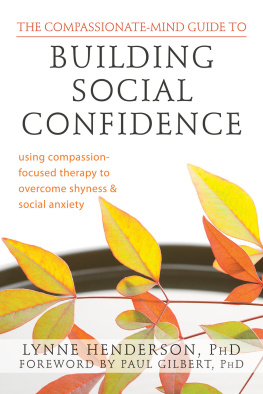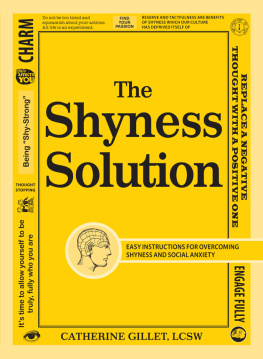IMPROVING SOCIAL CONFIDENCE
AND REDUCING SHYNESS
USING COMPASSION FOCUSED
THERAPY
LYNNE HENDERSON
ROBINSON
London
Constable & Robinson Ltd
3 The Lanchesters
162 Fulham Palace road
London W6 9ER
www.constablerobinson.com
First published in the UK by Constable,
an imprint of Constable & Robinson Ltd, 2010
Copyright Lynne Henderson, 2010
The right of Lynne Henderson to be identified as the author of this
work has been asserted by her in accordance with the
Copyright, designs and Patents Act 1988
All rights reserved. This book is sold subject to the condition that it shall not, by way of trade or otherwise, be lent, re-sold, hired out or otherwise circulated in any form of binding or cover other than that in which it is published and without a similar condition including this condition being imposed on the subsequent purchaser.
A copy of the British Library Cataloguing in
Publication data is available from the British Library
Important Note
This book is not intended as a substitute for medical advice or treatment. Any person with a condition requiring medical attention should consult a qualified medical practitioner or suitable therapist.
ISBN: 978-1-84901-202-7
Printed and bound in the EU
1 3 5 7 9 10 8 6 4 2
Contents
Preface
Lets start with a brief account of my history with shyness. What is now the Palo Alto Shyness Clinic developed from the Stanford Shyness Clinic, which was set up in 1977 and opened to the public shortly before I became director in 1982. The Stanford Shyness Clinic in turn had grown out of a famous study carried out by Philip Zimbardo in 1971, in which normal college students were randomly assigned the role of prisoner or guard in a simulated prison in the basement of the psychology building. The study was supposed to run for two weeks; but the prisoners became so anxious, and the guards so cruel, that it had to be stopped after six days. Phil and his students formed a seminar to try to understand what had happened. During their discussions, one of his students said that shyness was like being both a prisoner and a guard towards the self. The prisoner self wanted to come out, but was afraid, and the guard self was hostile and kept the prisoner trapped. Inspired by this insight, Phil and his students established the shyness clinic and started to gather data which culminated in Zimbardos book, Shyness.
From the time I became director of the Shyness Clinic, Phil Zimbardo served as a consultant and research supervisor and collaborator. Through my work with groups of shy people over the following years I began to realize that the vast majority of extremely shy and socially anxious people did not lack social skills when they felt accepted and respected. In fact, they demonstrated considerable social skills when they were not in the spotlight. I also noticed that they were conscientious and collaborative, and considerate of other group members. They were enormously relieved to be with other people they liked and respected and who also considered themselves as shy. Each one usually believed they were the most shy and inadequate in the group. I became struck more by their strengths than their weaknesses but I also saw how much they struggled with shame and self-blame, and how great their suffering could be. And yet in spite of that we usually managed to have a good time in the groups, with humour and laughter at ourselves playing a big role.
These shy people they were so hard on themselves and felt so much shame that I realized they felt stigmatized for their shyness and considered it a disease that needed a cure. That seemed to me absolutely the wrong way to look at the problem, because it led them to feel powerless to change their own situation. I therefore decided that treatment needed to be based on an approach in which people were treated with respect as colleagues learning alongside myself and my fellow practitioners about what it might take for all of us to be socially fit. And so, at the clinic, we gently refused their invitations to be dominated and instead asked for their input on role-plays, asked them to offer criticism and comment on the book we used for social skills training, and invited them to give us feedback on whether or how much particular exercises in the groups were helpful and how they felt towards us. When they began to confront me the groups became very lively, and soon the participants were beginning to take leadership roles in the group. From there we moved on to work on developing trust, verbal and non-verbal self-expression, listening skills, non-verbal communication, handling conflict and self-assertion.
In this new phase of the work we addressed negative automatic thoughts, such as When people see my discomfort they feel superior, People do not identify with me when I am uncomfortable, People will be rejecting and hurtful if I let them close to me. Listening to what clients said in groups and comparing this to what students (both shy and not shy) said on the same points, we discovered that our clients in the shyness clinic had more of these negative automatic thoughts about others than either shy or non-shy students. These findings suggested that chronically shy people and those with social anxiety disorder (discussed in Chapter 1) also had difficulty trusting others, in that they viewed others as critical, condescending and hurtful. We also found that although, through group work in the clinic, our clients were able to reduce self-blame and shame, negative thoughts about others, resentment, shyness and depression, once the group work was over they still seemed to have trouble managing their emotions. I wanted to find ways to help clients hold on to what they had gained in treatment, and to find out what would help them to cultivate compassion for themselves in the long term as well as to manage their emotions. With these aims in mind, I was exploring mindfulness techniques with the intention of incorporating them in treatment at the clinic.
That is when I met Paul Gilbert. I had heard about his work in Compassionate Mind Training, was fascinated and impressed, and wanted to learn more. I attended a workshop in England and realized I needed to learn a lot more about the compassion focused therapy he was developing, which seems to me to have enormous potential for treating chronic shyness and social anxiety disorder.
When Professor Gilbert invited me to write a book on a compassionate approach to shyness, I welcomed the chance. I am deeply grateful to him for the opportunity, and for helping me in the writing and revision of several chapters. He is a kind and patient man, for which I respect him as much as for his expertise and competence in combining his understanding in several fields to help us all lead more compassionate lives.
This book is the result.
Lynne Henderson
Acknowledgements
Many thanks go to Philip Zimbardo, mentor, colleague, friend and co-director of the Shyness Institute, our non-profit research and public education organization. From his passionate lecture about the famous Stanford prison study and his seminal research, which drew me into the treatment of chronic and painful shyness as director of the Shyness Clinic, through his original shyness treatment, which I developed in the following years, to our research collaborations at Stanford University, his support and mentorship have been the foundation of my work with shyness. He both gave me the freedom to develop independently and supported me when I got stuck, whether intellectually or emotionally. I am deeply grateful for his faith and trust in me, and for being the one of the most exciting people with whom to brainstorm and explore ideas about shyness. Thanks also to Paul Gilbert, who trusted me to write this book applying his compassion-focused approach to chronic shyness, and who let me combine it with my Social Fitness Training model. Thanks to Sally Reese, whose clinical expertise, friendship and writing skill contributed greatly to early drafts of this manuscript, to Fritha Saunders, my editor at Constable & Robinson, who helped me develop a more accessible writing style, and to my copy-editor, Gillian Somerscales. Thank you to my children, Kimberly, Mark and Brooke, who anchor me in terms of what is important in life, and whose humour, love and candid feedback provide laughter and grounding; and to my husband, Austin, best friend, love and research partner, for whom I am grateful every moment, whose life is built around his curiosity and his dedication to making computers serve their users. With him I share the belief that the people for whom we are designing are equal partners in the design. Finally, thanks to my shy clients, whose expertise and wisdom have guided and continue to guide me. They are my most powerful research colleagues.













